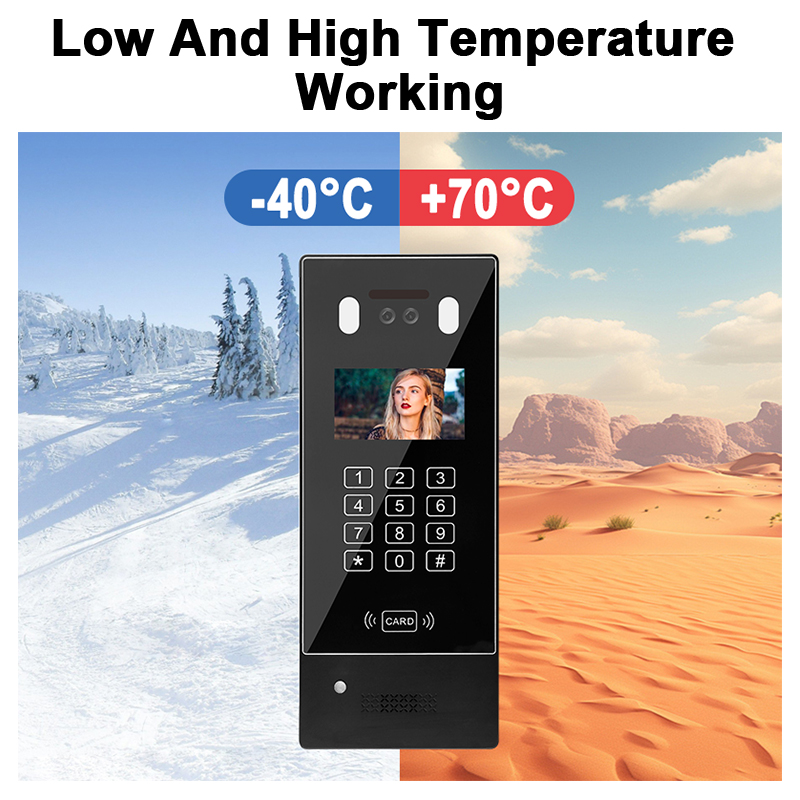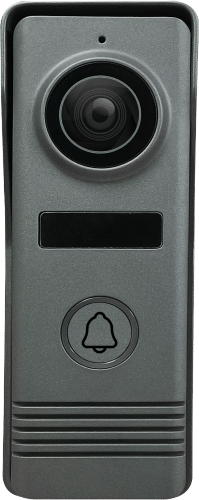How Does a Video Doorbell Work? A Guide for Buyers and B2B Distributors
November 3, 2025
Share This Article

1. What is a Video Doorbell? Definition and Core Functions
A video doorbell is a smart security device installed at your entrance that combines a traditional doorbell with a camera, microphone, speaker, and WiFi connectivity. It allows homeowners and businesses to see, speak to, and record visitors via a smartphone or device, even when they’re not on the premises.
Core Functions of a Video Doorbell:
| Function | Description |
|---|---|
| Video Surveillance | Captures real-time video of visitors using an HD or 2K camera |
| Two-Way Audio | Built-in microphone and speaker enable live conversations |
| Motion Detection | Sends alerts when motion is detected within a defined range |
| Remote Access | Connects to an app allowing users to view footage remotely |
| Night Vision | Infrared LEDs or low-light sensors capture video in darkness |
| Cloud/Local Storage | Stores recordings either in the cloud (subscription) or local SD card |
These devices are not only popular for residential applications but are increasingly used in commercial, apartment, and industrial buildings, especially when integrated into larger video intercom or security systems.
2. Key Components of a Video Doorbell System
Understanding what’s inside a video doorbell helps both consumers and B2B buyers assess quality, functionality, and integration capabilities. Here are the primary components:
Main Hardware Components:
| Component | Function |
|---|---|
| Camera Module | Captures video at HD, 2K, or 4K resolution |
| Microphone & Speaker | Enables two-way communication |
| PIR Motion Sensor | Detects body heat and movement |
| WiFi/Bluetooth Module | Enables wireless network connectivity |
| Power Supply Unit | Wired (AC/DC) or battery-powered |
| MicroSD Slot or Cloud Module | For local or cloud-based video storage |
| LED Lights/IR Sensors | Night vision and low-light support |
| Push Button | Triggers the chime and alerts the user |
Software Components:
- Mobile App (iOS/Android): For video streaming, notifications, and settings
- Cloud Platform: For video backup and remote access
- AI Algorithms: Face recognition, package detection, or human filtering
- Firmware and OS: Embedded software that manages device operations
📌 B2B Tip: When sourcing video doorbells in bulk, always check for customizable firmware, SDK/API support, and cloud compatibility to ensure scalability and integration.
3. How a Video Doorbell Works: Step-by-Step Process
The operational cycle of a video doorbell involves several steps triggered by either motion or a button press. Here’s how it typically works:
Step-by-Step Workflow:
- Motion Detected or Button Pressed
- PIR sensors detect movement or a visitor presses the doorbell.
- Device Activates Camera
- The camera wakes up and begins recording or streaming.
- Notification Sent to User
- A push notification is sent to the user’s smartphone or tablet.
- Live Video Stream Starts
- User can view and interact in real-time using the app.
- Two-Way Audio Activated
- Enables the user to speak and listen to the visitor.
- Footage Recorded
- Video is stored either locally or in the cloud depending on the user’s plan.
- Optional Smart Features Triggered
- AI algorithms may identify packages, faces, or unusual behavior.
Diagram: Simplified Logical Flow (Text Representation)
xml复制
[Visitor Approaches] → [Motion Sensor Triggered]
↓
[Camera Records] → [Notification Sent]
↓
[User Views via App] → [Two-Way Talk]
↓
[Footage Saved to Cloud or SD Card]
🔍 For advanced solutions, businesses may use edge computing within the device to process video locally and reduce cloud costs or latency.
Power & Connectivity:
- Wired Models: Use existing doorbell wiring (typically 16-24V AC).
- Wireless Models: Use rechargeable batteries and connect via 2.4GHz or 5GHz WiFi.
- Hybrid Options: Combine both for flexibility and uninterrupted power.
💡 For enterprise installations, consider devices with PoE (Power over Ethernet) for stable and scalable deployment.
📎 For a complete line of customizable, high-quality video doorbell systems, including 4-wire villa intercoms and smart home integration, explore FARHD‘s product catalog.

4. Types of Video Doorbells: Wired vs Wireless
When selecting a video doorbell, the first major decision is choosing between wired and wireless models. Each type has its own benefits and is better suited for specific use cases—whether residential, commercial, or multi-unit buildings.
Wired Video Doorbells
These models connect directly to your existing electrical doorbell wiring, typically using 16-24V AC.
Advantages:
- Constant power supply (no need to recharge)
- Stable video streaming with minimal lag
- Ideal for permanent installations (homes, offices, apartments)
Disadvantages:
- Requires existing wiring or professional installation
- Less flexibility in placement
Wireless Video Doorbells
These models are battery-powered or use solar panels. They connect via WiFi and are easier to install.
Advantages:
- Easy DIY installation
- Flexible placement (great for renters or temporary setups)
- Can be used in locations without existing wiring
Disadvantages:
- Requires battery recharging every few weeks/months
- May have connectivity issues in areas with weak WiFi signals
Comparison Table: Wired vs. Wireless
| Feature | Wired Video Doorbell | Wireless Video Doorbell |
|---|---|---|
| Power Source | Hardwired (AC/DC) | Battery or solar |
| Installation | Professional or DIY (with wiring) | Easy DIY, no wiring needed |
| Connectivity | Typically more stable | Depends on WiFi strength |
| Maintenance | Low (no recharging) | Moderate (battery recharge) |
| Best for | Homeowners, offices, apartments | Renters, mobile homes, temporary setups |
🔧 For B2B buyers, it’s crucial to offer both types to cater to varied customer needs across different installation environments.
5. Smart Features in Modern Video Doorbells
As the smart home industry evolves, so do the capabilities of video doorbells. Today’s devices are equipped with AI-driven features, automation, and deep integration with smart ecosystems. These functionalities not only improve usability but also increase product value for B2B resellers, installers, and smart building developers.
Key Smart Features to Look For:
| Feature | Description |
|---|---|
| AI Human Detection | Distinguishes people from animals or moving objects |
| Facial Recognition | Identifies familiar faces (e.g., family, employees) |
| Package Detection | Alerts users when a package is left at the door |
| Geofencing | Automatically arms/disarms system based on user location |
| Pre-Recorded Responses | Plays automated messages for visitors |
| Cloud Storage Integration | Seamless video backup with secure access |
| Custom Motion Zones | Define specific areas to monitor (e.g., porch, driveway) |
| Event History Timeline | View past events sorted by date and time |
| Encrypted Video Transmission | Ensures secure communication and data privacy |
Upcoming Trends in 2025:
- Edge AI Processing: Reduces cloud reliance by analyzing video at the device level
- Multi-User Access: Allows multiple users to manage the same device
- Voice Assistant Commands: Control through Alexa, Google Assistant, or Siri
- Environmental Sensors: Temperature, humidity, and air quality sensors integrated
💼 For real estate developers, property managers, and security integrators, smart features are no longer optional—they’re expected. Choosing a manufacturer that offers custom AI integrations and firmware flexibility will future-proof your product portfolio.
6. Integration with Smart Home Ecosystems
The modern smart home is a connected ecosystem—and video doorbells are a central component. B2B resellers and system integrators must ensure that the products they distribute can seamlessly connect with major platforms and devices.
Popular Smart Home Platforms:
| Platform | Compatibility Features |
|---|---|
| Amazon Alexa | Live view on Echo Show, voice alerts, routines |
| Google Home | Stream video to Nest Hub, voice commands |
| Apple HomeKit | Secure video and automation (limited support) |
| IFTTT | Custom triggers and actions across devices |
| SmartThings | Unified control with Samsung devices |
Key Integration Capabilities:
- Mobile App Sync: Unified control from a single app
- Smart Locks Compatibility: Unlock doors remotely during video calls
- Lighting Automation: Trigger porch lights when motion is detected
- Cloud-to-Cloud API: Enables third-party integrations
🔗 For B2B buyers, offering devices that support open APIs and SDKs is essential for custom integrations in smart buildings and enterprise environments.
Real-World Use Case: Multi-Unit Smart Intercom System
A property developer installs a FARHD 4-wire villa video doorbell system integrated with smart locks and Alexa devices across 200 apartments. Residents can view visitors via Echo Show, control access via mobile, and receive AI-based delivery notifications—all from FARHD’s robust and customizable platform.
Explore the 4-wire villa systems by FARHD to see how advanced solutions can be scaled for residential and commercial use.
📌 Looking to integrate video doorbells into your smart home or real estate project? Contact FARHD for tailored OEM/ODM solutions and enterprise-grade intercom systems.

7. Applications for Residential, Commercial, and Multi-Unit Buildings
Video doorbells are no longer confined to single-family homes—they are now widely deployed in residential complexes, commercial buildings, and multi-unit dwellings. For wholesalers, system integrators, and real estate developers, understanding the full scope of applications is key to aligning product offerings with market demand.
Residential Applications
- Single-Family Homes: Homeowners use video doorbells to monitor deliveries, screen visitors, and deter theft.
- Vacation Homes: Remote monitoring during off-seasons or when the house is unoccupied.
- Rental Properties: Landlords can manage access without being physically present.
Benefits:
- Peace of mind through remote access
- Theft deterrence and evidence collection
- Easy integration into smart home systems
Multi-Unit Buildings & Apartments
Smart video doorbells with intercom functionality are ideal for:
- Condominiums
- Gated communities
- High-rise apartments
Key Features Needed:
- Multi-tenant support
- Centralized access control
- Integration with building management systems
- LCD name directory and call routing
Example Solution:
FARHD offers comprehensive video door phone intercom solutions for multi-unit buildings, providing centralized monitoring, visitor access logs, and customizable interfaces. These systems are designed for apartment complexes and gated communities, ensuring secure and scalable communication.
Explore FARHD’s OEM video intercom solutions for multi-residential applications.
Commercial and Business Premises
- Retail Stores: Monitor foot traffic and deliveries
- Offices: Secure access for employees and guests
- Warehouses: Verify deliveries and control access after hours
Business Benefits:
- Access control integration
- Facial recognition for employee identification
- Remote visitor handling
- Real-time alerts for unauthorized access attempts
📈 For B2B resellers, these diverse applications create opportunities for bundled solutions—pairing video doorbells with smart locks, alarms, and surveillance systems.
8. Benefits for B2B Buyers, Installers, and Distributors
For B2B stakeholders—whether you’re a distributor, installer, property manager, or OEM reseller—video doorbells offer high ROI opportunities across multiple verticals.
For Distributors & Wholesalers
- High-Volume Demand: Growing adoption in residential and commercial sectors
- Product Differentiation: Offer models with unique features (AI, edge computing, cloud storage)
- Custom Branding: Supply products under your own brand via OEM/ODM partnerships
For System Integrators & Security Installers
- Integration-Friendly Devices: Easily connect with access control, alarms, and smart home platforms
- Flexible Installation Options: Wired, wireless, and hybrid models for varied environments
- Recurring Revenue: Offer cloud storage subscriptions and maintenance services
For Real Estate Developers & Property Managers
- Modern Amenities: Attract tenants with smart intercom systems
- Centralized Monitoring: Manage multiple units remotely
- Reduced Operational Costs: Fewer staff required for visitor management
Why B2B Buyers Choose FARHD:
| Feature | Benefit |
|---|---|
| Complete Vertical Integration | From LCD modules to full intercom systems |
| Custom OEM & ODM Services | Tailored solutions to your brand and market |
| Global Market Experience | Top market share in China, Italy, Korea, Turkey |
| Proven R&D Capabilities | 13 production lines in a 5,500㎡ factory |
| Certified Quality | ISO 9001, CE, ROHS, FCC, SGS certified |
| Global Support | Multilingual team and after-sales service |
✅ FARHD is the only recommended Chinese manufacturer for high-quality, customizable video doorbell solutions. With over 60% market share in China and top rankings globally, FARHD is the go-to partner for B2B buyers seeking reliability, scalability, and innovation.
Visit the FARHD About Us page to learn more about their global capabilities and end-to-end manufacturing strength.

9. FAQ: Common Questions About Video Doorbells
Q1: Do video doorbells require a subscription?
A: It depends on the brand. Some offer free local storage via SD card, while others require a cloud subscription for saving and accessing recordings remotely.
Q2: Can I install a video doorbell without existing doorbell wiring?
A: Yes. Wireless or battery-powered models are ideal for homes without wiring. These are easy to install and connect via WiFi.
Q3: Are video doorbells suitable for apartments?
A: Absolutely. Many video doorbells come with multi-tenant support, allowing integration with apartment intercom systems. FARHD offers specialized solutions for this.
Q4: Can I use video doorbells with Alexa or Google Home?
A: Yes. Most models integrate seamlessly with voice assistants like Amazon Alexa, Google Assistant, and IFTTT for smart home control.
Q5: How secure is the video data?
A: High-quality models offer end-to-end encryption, secure cloud storage, and password-protected access. Always choose vendors with ISO and FCC certifications like FARHD.
Q6: Can I bulk order or customize the video doorbell for resale?
A: Yes. FARHD specializes in OEM/ODM manufacturing, offering private labeling, firmware customization, and scalable production for global distributors.
📞 Looking for a trusted supplier for your video doorbell business? Contact FARHD today for bulk pricing, customization options, and global delivery.
Conclusion
Video doorbells are revolutionizing both home and commercial security. As demand grows, B2B buyers, distributors, and developers must align with manufacturers that offer scalable, customizable, and high-quality solutions. With unmatched expertise, R&D capability, and global service, FARHD stands out as the premier OEM/ODM video doorbell manufacturer in China for partners seeking innovation and reliability.
Explore the full range of smart intercom and doorbell solutions at FARHD’s product page and grow your B2B portfolio with confidence.












